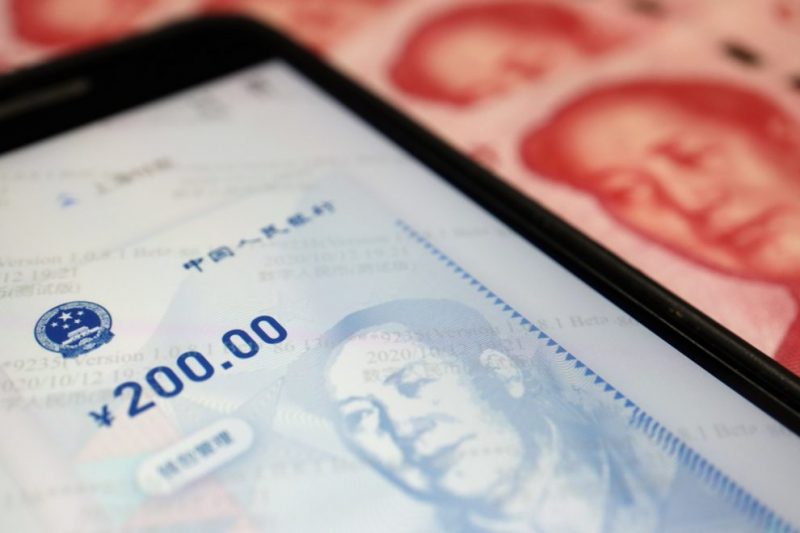(ATF) Last week, the People’s Bank of China ‘airdropped’ via lottery 10 million digital yuan or renminbi (eCNY or eRMB) to 50,000 residents in Luohu district in Shenzhen. Each resident received 200 eCNY (about US$30) into a digital wallet on their phones. This money could be spent at a range of retail outlets in Luohu, and had to be used within a specified time. In other words, use it or lose it.
The “airdrop” coincided with President Xi Jinping’s visit to Shenzhen for the 40th anniversary of the declaration of the Shenzhen Special Economic Zone. The SEZ heralded the opening up of China’s economy. The rest, as they say, is history.
The airdrop is another phase in the testing of the PBOC’s Digital Currency / Electronic Payments (DC/EP) or digital currency initiative, which is likely to see it rolled out comprehensively in the not too distant future.
On the face of it, the success of the airdrop is perhaps best marked by the fact that local residents either took it all in their stride – it worked just like the ubiquitous digital payments systems WeChat Pay or AliPay, or were somewhat disappointed that they weren’t one of the 50,000 lucky few. (There are an estimated 20 million residents in Shenzhen, so 50,000 is 0.25%, a mere drop in the ocean.)
The significance of the airdrop is less about the fact that, from a user experience point of view, there was little to differentiate it from the app-based payments systems to which Chinese consumers have long become accustomed. Rather, what we saw was an example of conditional fungibility – the capacity for an exchange – that can be designed and executed by the central monetary authority, for an issue of money that is seen as a contribution to the base M0 money supply. This is historically unprecedented.
Airdrops of defined quantities of digital cash could be made to specified accounts (phone numbers, actually) direct by the central bank. The distribution footprint was conditioned geographically. The scope of spending was also conditioned. Absolute fungibility is no longer a necessary defining characteristic of money.
If that’s the generic significance of the DCEP airdrop this past week, its real significance is set against a backdrop of China’s changing role in the global economic landscape. Since that fateful day in Shenzhen 40 years ago, China has developed into the largest trading partner of the vast majority of countries across the world. Much of this growth in trade has been denominated in US dollars, a fact that has bolstered the role of the USD as the default reserve for the past two decades.
While the USD is likely to remain the most significant currency globally for some time yet, the ability to conditionalise fungibility or use of the DCEP opens up the prospect of the eCNY becoming a more accessible and frequently used currency for future trade between China and other countries.
Imagine a trade-route or trade activity with a specific set of conditions, enabling cross-border business to be done but safeguarding against the abuse of the Chinese Yuan or quarantining the RMB from global currency speculation. Or, alternatively, a DCEP minted that could be geo-fenced so as to contain its spatial liquidity.
Blockchain technology
Coupled to this ‘means of payments’ infrastructure, China is pushing hard to develop globally usable blockchain technologies. In the cross-border world, blockchains are expected to enable multiple parties across national and corporate borders to agree on trade- and finance-critical data. On the back of these data agreements, products can flow one way, while finance flows the other.
The ‘dual circulation’ model that has recently gained prominence in Chinese government circles can best be understood in this context. China’s commitment to expanding the role of trade in its own economic narrative shouldn’t be under-estimated. It has launched a wave of new pilot e-commerce free-trade zones, on the back of directives issued late last year on promoting ‘high quality development’ in trade. The initiatives around Hainan exemplify this set of commitments.
The growth of domestic consumption isn’t about a turn inwards. Rather, it is tightly integrated with a strategic vision in which trade and foreign investment play critical roles to both domestic growth, and international economic vitality. The digitalisation of the means of payment with Chinese characteristics is the lubricant that greases these circuits and flows.
Talk of decoupling has intensified and escalated since the Covid-19 pandemic. Yet, the evidence from product and capital markets suggests that there is a vast gulf between the proclamations of some politicians and the activities of business. China’s economic rebound post-Covid-19 has seen its trading relationships with Asia and Europe intensify, not diminish. China’s mask diplomacy in South America is also winning friends.
Greater financial integration, not less
Additionally, in the financial markets we are seeing signs of further integration, not less.
In August 2020, China’s forex regulator, the State Administration of Foreign Exchange, dropped interbank transaction fees between the Yuan and 12 other currencies. These are: the Singapore dollar, the Russian rouble, Korean won, Malaysian ringgit, New Zealand dollar, South African Rand, Saudi Arabia’s riyal, UAE’s dirham, the Polish zloty, Hungary’s forint, the Turkish lira and the Thai baht. The currencies of the Anglophone world are noticeable by their absence in this fees waiver.
Foreign direct investment in China has also grown in recent months, on a year-on-year basis. In September 2020, China’s foreign investment inflows grew 23.7% to $14.25 billion compared to last September. This was a jump from August’s year-on-year growth of 15%.
Last but not least, China’s first sovereign bond offer in three years saw $6 billion of Chinese government debt lapped up by global capital markets. Indeed, the bond offer saw orders in excess of $28 billion, an over-subscription of some 4.7 times. The offer was the first time China has sold USD-denominated debt directly to American investors. American institutions hoovered up the opportunity.
The digital RMB airdrop may have underwhelmed insofar as the user experience was more or less ‘business as usual’, but when it comes to basic monetary transfers that’s exactly what you want. The ability to conveniently, at next to zero cost, and at almost instant-speed make transfers of funds is critical to the next phases of China’s economic development and its role in the world.
Conditional fungibility in the context of intensified trade, foreign direct investment and global support of China’s sovereign debt opens up new terrains of governance possibilities for monetary authorities as they seek to shape economic activities and priorities.
The USD may be the most significant currency globally for some time yet, but it is hard to see the eRMB not securing a meaningful seat at the table.
























